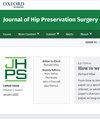Risk factors for long-term hip osteoarthritis in patients with hip dysplasia without surgical intervention
IF 1.4
4区 医学
Q3 ORTHOPEDICS
引用次数: 3
Abstract
ABSTRACT Hip dysplasia is a common cause of hip pain and a known risk factor for hip osteoarthritis (OA) and early total hip arthroplasty (THA). Unfortunately, little is known about the specific factors associated with an increased risk of OA. The purpose was (i) to report the overall rate of symptomatic hip OA and THA and (ii) to identify radiographic features and patient characteristics associated with the development of symptomatic hip OA. A geographic database was used to identify all patients aged 14–50 years old diagnosed with symptomatic hip dysplasia between 2000 and 2016. Kaplan–Meier analysis was used to determine the rate of symptomatic hip OA, defined as a Tönnis grade of ≥1 on hip radiograph. Univariate and multivariate proportional hazard regression models were performed to determine risk factors for OA. One hundred and fifty-nine hips (144 patients) with hip dysplasia (52 F:107 M) out of 1893 patients with hip pain were included. Of these, 45 (28%) had severe hip dysplasia with a lateral center-edge angle ≤18°. Mean age at time of presentation was 26.1 (±10.1) years. Mean follow-up time was 8.2 (±5) years. The rate of OA was 20%. THA was performed in 11% of patients. Body mass index >29 (P = 0.03) and increased age (P < 0.01) were risk factors for OA. Patients with symptomatic hip dysplasia are at significant risk of developing hip OA. Body mass index >29 and age ≥35 years at the time of presentation with hip pain were risk factors for hip OA.无手术干预的髋关节发育不良患者长期髋关节骨关节炎的危险因素
髋关节发育不良是髋关节疼痛的常见原因,也是髋关节骨关节炎(OA)和早期全髋关节置换术(THA)的已知危险因素。不幸的是,我们对与骨关节炎风险增加相关的具体因素知之甚少。目的是(i)报告症状性髋关节OA和THA的总体发生率,(ii)确定与症状性髋关节OA发展相关的影像学特征和患者特征。使用地理数据库确定2000年至2016年期间诊断为症状性髋关节发育不良的所有14-50岁患者。Kaplan-Meier分析用于确定症状性髋关节骨性关节炎的发生率,定义为髋关节x线片Tönnis分级≥1。采用单因素和多因素比例风险回归模型确定OA的危险因素。在1893例髋关节疼痛患者中纳入了144例髋关节发育不良患者(52例F:107例M)。其中,45例(28%)有严重的髋关节发育不良,外侧中心边缘角≤18°。发病时平均年龄26.1(±10.1)岁。平均随访时间8.2(±5)年。OA率为20%。11%的患者行THA。体重指数bbb29 (P = 0.03)和年龄增加(p29和出现髋关节疼痛时年龄≥35岁)是髋关节骨性关节炎的危险因素。
本文章由计算机程序翻译,如有差异,请以英文原文为准。
求助全文
约1分钟内获得全文
求助全文

 求助内容:
求助内容: 应助结果提醒方式:
应助结果提醒方式:


